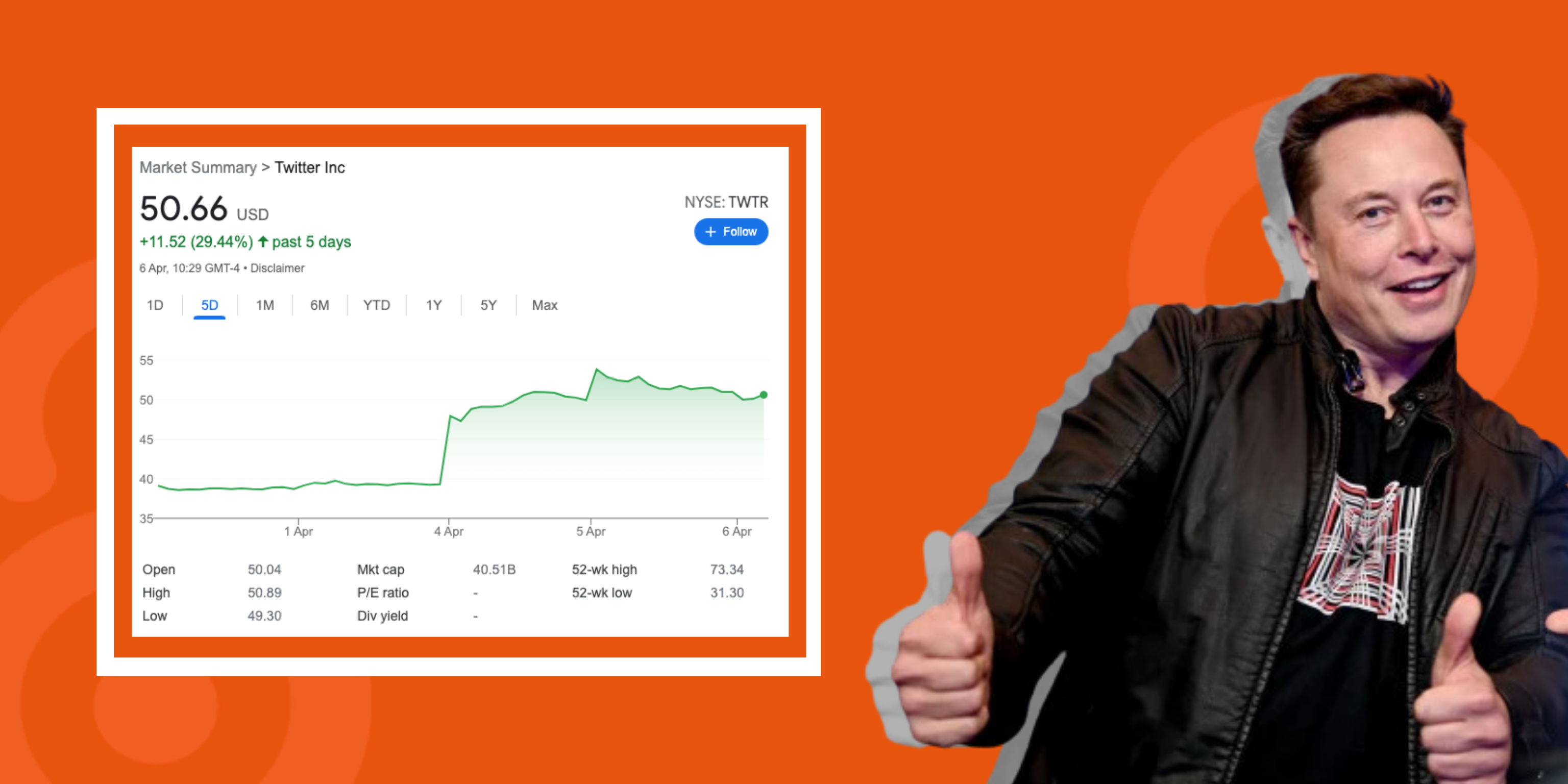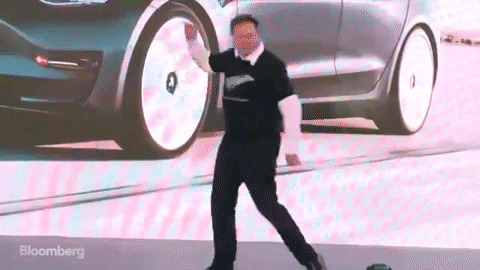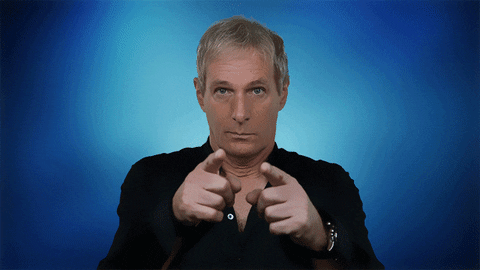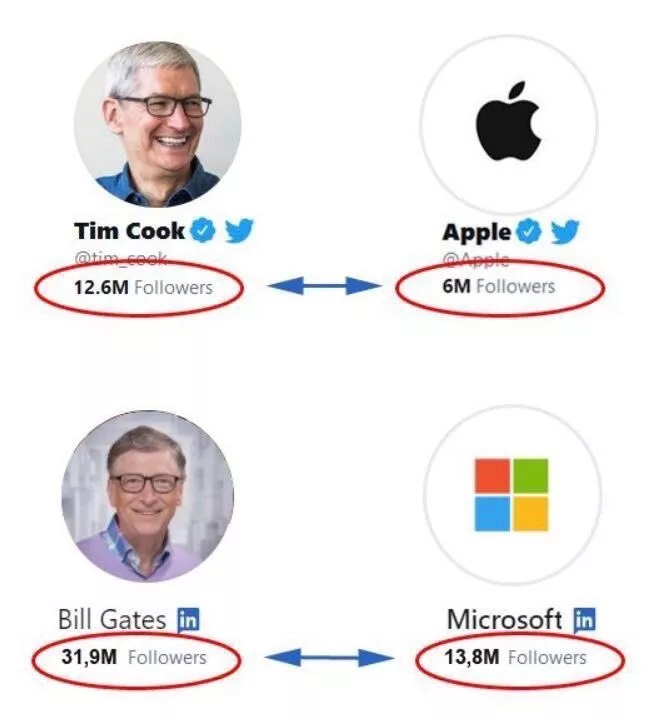
Whew 😪
It’s been a wild few days for stock trading, hasn’t it?
Unless you’ve been living under a rock.
Or spent no time online.
You will have seen the news that Elon Musk has bought a majority stake in Twitter.
A 9.2% stake worth $2.89 billion, to be exact.
It seemed inevitable.
After tweeting to his 80 million followers in recent weeks about what he perceives as Twitter’s flaws.
And repeatedly questioning whether the site adheres to the principles of freedom of speech.
(Even, at one point, hinting at starting his own social network).
He decided to do something about it.
And bought a majority stake in the NYSE-listed company.
Causing the greatest intraday surge in their share price since their IPO listing in 2013 📈
A testament to the power of Musk’s personal brand.
And his ability to move markets with less than 280 characters.
But alas, this isn’t Bloomberg or the Financial Times.
And I’m a marketer, not an economist 🤷♂️
So, I want to draw your attention to something entirely different here.
And if you hadn’t guessed by the title…
I’m talking about the power of Elon’s personal brand.
And the level of influence senior leaders wield on social media.
Or, as we call it: Executive Influence.

What is Executive Influence?
Put simply…
It’s the influence a company’s senior leadership team have over its audiences on social media.
Generally speaking, senior leaders will be the people with the largest networks/followings within your organization, and they tend to be connected to other senior leaders within the same industry too 👌
In the current social media-led business landscape where consumers are asking for trust, authenticity and operational transparency from brands, a CEO can be just as much a part of a company’s brand as the product or services that it offers.
And so they are an invaluable voice within the company! 🙌
This is especially true for larger companies, as often a CEO change or a promotion to the board will bring with it some media attention, namely because the individual brings with them their own followers and reputation (or personal brand).
Their personal brands are shaped by companies they’ve previously worked with, the successes they’ve driven, and how they’re perceived publicly, whether in the press or on social media.
Sound familiar? 👇

Take former T-Mobile CEO John Legere, as another example.
Currently, Legere has 5.4 million followers on Twitter.
However, at the end of his tenure with T-Mobile…
Legere had amassed an audience size of 6.4 million followers.
While T-Mobile, currently, boasts 1.4 million followers.
That’s some difference, right? 🤯
The social-savvy CEO used the platform to show off his exuberant personality, while also discussing T-Mobile products and sharing the latest company news.
His likeable personality allowed followers to put a face to the brand and associate it with a person they’d come to like!
Isn’t this the very nature of what influencers have been doing for years now? 🤔

You Don’t Have to Be Elon
If you frequent LinkedIn.
You might have seen this one circulating a while back 👇

It highlights a few Fortune 500 CEOs.
And brilliantly shines a light on the size of their audiences vs the companies they work for.
Up until now, you might have been thinking:
“Oh, this is Elon Musk… It’s the most extreme example.”
And to some extent, you’d be right! 🤷♂️
After all, not many CEOs can compete with Musk’s following.
(If any, in fact)
Plus, Bill Gates is an industry icon!
And EVERYONE wants to hear about Tesla, right?
Well, not every influencer will be a Kardashian.
But you’d better believe even the most niche of micro-influencers generate results! 💸
An executive’s influence, no matter the size of their following compared to Elon Musk, is huge.
It’s not just the Fortune 500 companies.
It’s ANY company.
If you’re a B2B brand with 200 employees, you might also have a few (or tens of) thousands of followers across social media.
But how many does your C-Suite have collectively?
And what does it mean for a message to come from THEM vs a branded post?
This is especially true on sites like LinkedIn.
It’s no secret that LinkedIn’s algorithm doesn’t favour company posts 🤦♂️
And yet many companies still consider this to be the best channel to share the latest news from within their organization.
The reality is that your senior leaders’ posts are more likely to be seen by your key audiences, but they’re more likely to generate engagement too.
And, in most instances, have an immense impact on the business.
Engagement comes in the form of likes, sure.
But it also means conversations in the form of comments.
And website traffic in the form of clicks.
CPC rates continue to increase 😩
And there’s a reason why Tesla hasn’t spent a dime on paid advertising…

How to #ActivateYourElons!
Okay.
So, where to begin? 🤔
You can’t just spew the facts.
Or send your CEO this article.
They’re busy as hell 😰
And brand awareness isn’t their job, right?
So, if you want to activate your senior leadership team on social media.
You’re going to need the right tools 💪
Not only to get them sharing more of your company’s content.
But to ensure that they’re able to do so in a time-effective manner.
(And without causing your PR team to lose sleep over something they’ve said!) 🙏
What you’ll want is an employee advocacy platform that comes equipped with the features you’ll need to get your busy senior leaders more active online.
An employee advocacy program platform like DSMN8 allows any and all employees to find and share the latest company content with the push of a button.
We even offer an optional automation feature which means those busy bees will be able to automatically share the latest pre-approved company and industry news for you.
Pre-approved content?
Pre-approved by who?
Your platform’s dedicated admin users!
These are typically a few of your marketing, PR or comms professionals.
Ensuring that no one is ever stuck for something to say.
And no one has to worry about your CEO saying the wrong thing! 🙌
Ready to get started with the #1 employee advocacy platform?
Wondering how active your team already is, and how this compares with your competitors?
More on employee influence 👇
Lewis Gray
Senior Marketing Manager and Employee Advocacy Program Manager at DSMN8. Lewis specialises in content strategy, growing brand visibility and generating inbound leads. His background in Sales lends itself well to demand generation in the B2B niche.


